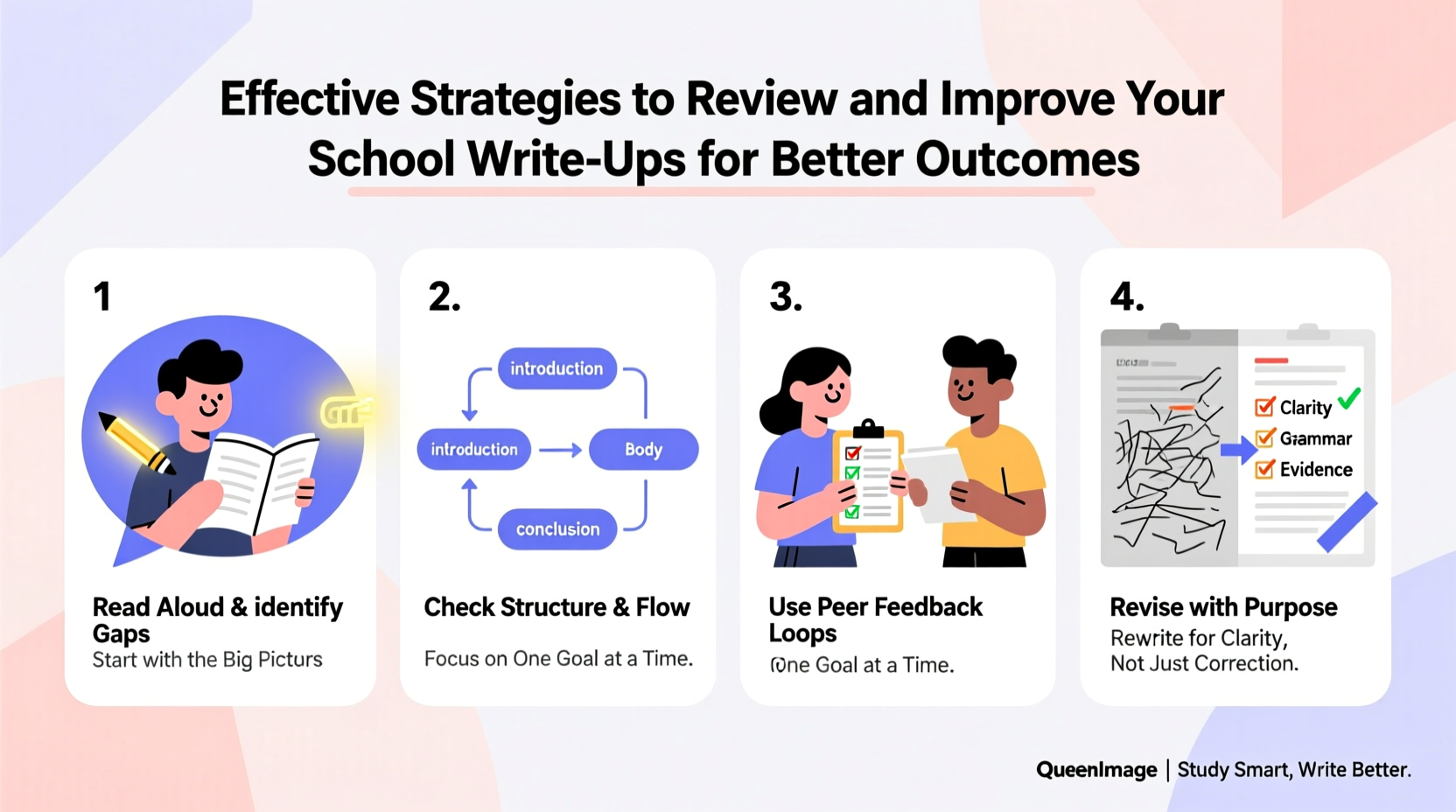Well-crafted school write-ups—whether essays, reports, reflections, or research papers—can significantly influence academic performance. A strong piece of writing doesn’t just convey information; it demonstrates critical thinking, clarity, and engagement with the subject. Yet many students submit drafts without thorough review, missing opportunities to elevate their work. The difference between an average and an outstanding grade often lies not in raw talent but in deliberate revision. By adopting structured, thoughtful strategies, you can consistently refine your writing and achieve better outcomes.
1. Step Back Before You Edit

One of the most overlooked aspects of effective revision is timing. Editing immediately after writing limits objectivity. Your mind still holds the original intent, making it difficult to spot gaps in logic or unclear phrasing. Instead, allow time between drafting and reviewing—ideally 24 hours. This mental distance enables a fresh perspective, helping you read your work as a teacher or peer might.
2. Use a Structured Revision Process
Revision should be more than scanning for spelling errors. It’s a layered process that addresses different aspects of writing in stages. Follow this step-by-step timeline to ensure comprehensive improvement:
- First Pass – Content & Structure: Ask whether your main argument is clear, supported by evidence, and logically organized. Does each paragraph serve a purpose?
- Second Pass – Clarity & Flow: Focus on sentence structure, transitions, and readability. Are ideas connected smoothly? Is jargon explained?
- Third Pass – Grammar & Mechanics: Check punctuation, verb agreement, tense consistency, and spelling. These may seem minor, but they affect credibility.
- Final Pass – Formatting & Requirements: Confirm alignment with assignment guidelines—font, spacing, citation style (APA, MLA, etc.), word count.
This tiered approach prevents overwhelm and ensures no critical layer is neglected.
3. Apply a Writing Improvement Checklist
To maintain consistency across assignments, use a checklist tailored to academic writing standards. Refer to it during each revision phase:
- ✔️ Does the introduction clearly state the purpose or thesis?
- ✔️ Is every claim supported with relevant examples or data?
- ✔️ Do paragraphs begin with topic sentences and end with logical transitions?
- ✔️ Are sources properly cited both in-text and in the reference list?
- ✔️ Is the tone formal and objective (unless personal reflection is required)?
- ✔️ Have I eliminated redundancy and vague language (e.g., “a lot,” “stuff”)?
- ✔️ Did I proofread aloud to catch awkward phrasing?
Checklists reduce cognitive load and increase accountability, especially when preparing multiple assignments simultaneously.
4. Leverage Peer Feedback and External Review
Even careful self-editing has blind spots. Another reader can identify confusing sections, logical inconsistencies, or tone issues you might miss. Exchange drafts with a classmate or join a study group focused on writing improvement. When sharing your work, ask specific questions: “Is my argument clear in paragraph three?” or “Does the conclusion effectively summarize the key points?”
“Students who engage in peer review improve not only their current draft but also develop stronger self-editing skills over time.” — Dr. Laura Simmons, Education Researcher, University of Toronto
If peer options are limited, read your work aloud—preferably to an imaginary audience. Hearing your words exposes rhythm issues and unnatural expressions. You’ll often catch a run-on sentence or weak transition simply by listening.
5. Analyze Common Pitfalls with Real Examples
Understanding mistakes through real-world scenarios makes improvement tangible. Consider this mini case study:
Maria wrote a 1,200-word essay on the causes of World War I. Her first draft included detailed facts but lacked a unifying argument. She listed events chronologically without explaining how they interconnected. After receiving feedback, she revised using the structured process above.
In her second draft, she opened with a clear thesis: “While nationalism and militarism contributed, the alliance system was the primary catalyst for rapid escalation.” She reorganized paragraphs thematically, added analysis linking causes, and strengthened transitions. The result? Her grade improved from a B- to an A, and her teacher noted “excellent development of historical argument.”
Maria’s experience illustrates that factual knowledge alone isn’t enough—structure and insight determine impact.
Do’s and Don’ts of School Write-Up Revision
| Do’s | Don’ts |
|---|---|
| Revise in multiple passes focusing on different elements | Try to fix everything in one reading |
| Use feedback to identify recurring weaknesses | Ignore repeated comments from instructors |
| Cite sources as you write to avoid omissions | Leave citations until the final minute |
| Read your work aloud to detect awkward flow | Rely solely on spellcheck for accuracy |
| Align formatting with assignment requirements | Assume all teachers accept the same style |
FAQ
How can I improve my writing if English isn’t my first language?
Focus on clarity over complexity. Use simple, precise vocabulary and short sentences. Tools like Grammarly or Hemingway Editor can help identify confusing phrasing. Additionally, visit your school’s writing center—many offer specialized support for multilingual learners.
Is it worth revising after getting feedback on a graded paper?
Absolutely. Revising a graded assignment turns it into a learning tool. Update it based on instructor comments and resubmit if allowed, or keep the improved version as a model for future work. This practice builds long-term writing proficiency.
What if I don’t have time for multiple revisions?
Prioritize the most impactful steps: check your thesis, ensure each paragraph supports it, and verify correct citations. Even 15 minutes of targeted editing can prevent point deductions for clarity and format.
Conclusion
Improving school write-ups isn’t about perfection on the first try—it’s about progress through disciplined review. By stepping back, applying structured methods, using checklists, seeking feedback, and learning from real examples, you transform writing from a chore into a strategic advantage. Every revision sharpens your voice, strengthens your arguments, and increases your academic confidence. Better outcomes aren’t accidental; they’re written, rewritten, and refined.









 浙公网安备
33010002000092号
浙公网安备
33010002000092号 浙B2-20120091-4
浙B2-20120091-4
Comments
No comments yet. Why don't you start the discussion?